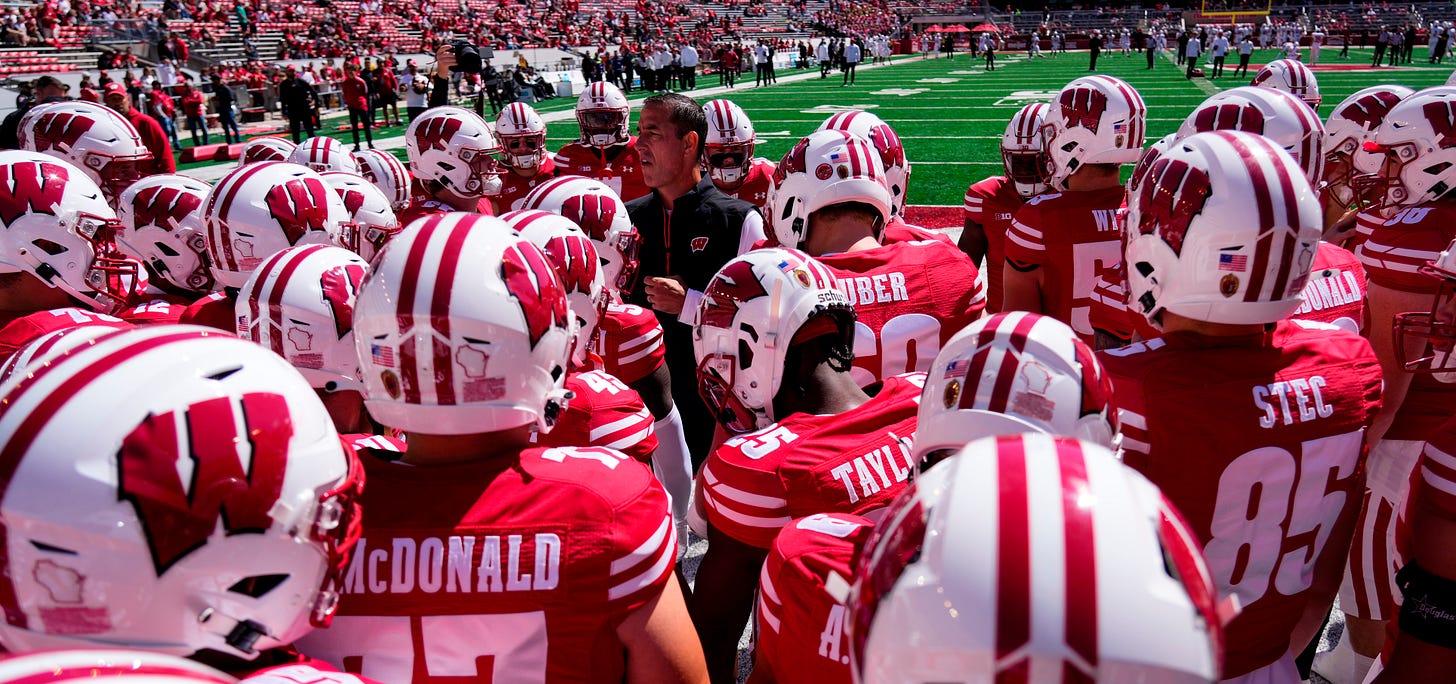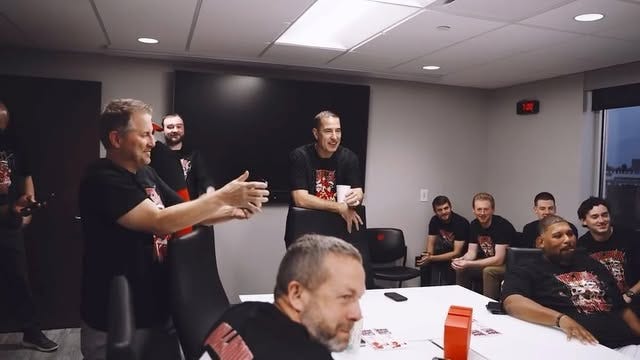Where Wisconsin football stands in the 2026 class entering official visit season
Official visit season is here. Here's where the Wisconsin football program stands in the 2026 recruiting class—and what the next few weeks could mean.
There’s a public perception that recruiting is a year-round grind. And that’s true. But some stretches carry far more weight than others—and for the Wisconsin football program, that stretch is officially here.
This coming weekend, the Badgers enter a pivotal three-week window that will shape the future of their 2026 recruiting class. This isn’t just a calendar filler. This is go-time. And if you know how Luke Fickell and his staff like to operate, you know these upcoming official visits matter a ton.
From May 30 through mid-June, Wisconsin is expected to host more than 30 of the staff's top-of-board high school recruiting targets on official visits.
These are the players who could end up shaping the core of the next great Badgers class. And for a program still trying to find an identity under Fickell, this stretch is where momentum can really start to shift.
Unlike unofficial visits, these weekends are fully funded—flights, hotels, meals, the whole deal—and they offer 48 hours of direct exposure to the football program.
Recruits get to sit down with coaches, tour facilities, hang with current players, check out campus life, and picture themselves in the locker room. It’s a big deal for the players and their families.
The names coming to town back that up.
Four-star running back Amari Latimer — brother of transfer cornerback Geimere Latimer — headlines the group this weekend. A physical between-the-tackles runner out of Tyrone, Georgia, Latimer’s game is well suited to become a potential bell cow for Wisconsin. He would be a legitimate foundational piece for a class that still needs a scholarship tailback.
While Wisconsin was once viewed as the favorite, Tennessee has been turning up the heat in Latimer's recruitment—so if the Badgers want to stay in pole position, they’ll need to bring their best.
Receiver Jayden Petit, who is out of Florida, is another blue-chip talent to keep an eye on. A 6-foot-4 vertical threat with real leaping ability, he’d be one of the more dynamic outside targets Wisconsin has landed on the recruiting trail in recent memory. Longtime target Zachary Washington will also be on campus—he’s been on the board for a while, and this staff would love to lock at least one of them up before the weekend’s over.
Then there’s Jackson Samuels Ford—a four-star edge rusher from Pennsylvania who checks all the boxes this staff wants in its new-look front seven. Long, athletic, disruptive. The kind of player who fits exactly what Mike Tressel wants to build moving forward. That said, his visit schedule also includes Kentucky, Penn State, Ohio State, and Michigan.
And don’t sleep on four-star offensive tackle Kamari Blair or even defensive lineman Djidjou Bah. The Tennessee native isn’t ranked as highly as some of the others, but the three-star prospect has already shown he’s serious about Wisconsin. He made the Badgers his first official visit. That’s not just a scheduling detail—that’s a sign of real interest.
There’s also the matter of in-state recruiting—which, let’s be honest, has been a hot-button topic ever since Fickell and his staff took over in Madison. And right now, as we sit here looking at the 2026 cycle, Wisconsin doesn’t have a single in-state commit. Not yet, anyway.
But here’s a nugget worth holding onto: Wisconsin was a school of real interest for Appleton North linebacker Ben Wenzel before the scholarship offer came. That tells you a lot. Now, with his official visit locked in for May 29, I feel pretty confident saying the Badgers are in the driver’s seat—and so does the staff.
Of course, this stretch comes at a critical juncture—and if Wisconsin is going to turn recruiting momentum into real results on the field, the infrastructure behind the scenes has to match the urgency.
This has been an offseason full of changes inside the Wisconsin football program's front office. General Manager Max Stienecker left for a new opportunity at USC, prompting the Badgers to pivot and bring in Deputy Athletic Director Marcus Sedberry to help fill that evolving role.
From there, the Badgers hired Ethan Russo as Director of Player Personnel, reshaped the recruiting department, and now have a new offensive identity under Jeff Grimes to pitch—one that fits the program and gives recruits a clearer vision of what they’d be signing up for.
This is where things start to crystallize.
In the NIL and transfer portal era, programs don’t get four or five years to develop players anymore. Most of the time, you get two—maybe less. If a recruit doesn’t see an opportunity to earn meaningful reps early in their career or carve out a path to the field, chances are he’s back in the portal looking for a better fit. That’s the new normal. And Wisconsin's staff understands that.
“You’ve got to rely upon young guys a lot more,” Fickell told reporters on National Signing Day. “And whether that’s in every program or not, what we’re seeing is the trend will continue. Those second-year guys, one of two things: they either can’t play, maybe at that point in time or [they] don’t see themselves playing there. So, to me, I see 25, 30 guys you’ve got to bring in every year, high school guys.
"You’ve got to get them to trust and believe and be able to develop them and get them on the field at an earlier age," Fickell continued. "And these guys are going to have that opportunity.”
To counter that trend, Fickell and his staff have quietly changed their approach. You’re seeing them target more college-ready bodies—guys who don’t need two or more years in a weight room before they’re ready to contribute or compete for spots in the two-deep. It’s about reducing risk and accelerating timelines. The less you have to project, the more likely you are to retain talent and build around it. It also helps that some programs are more focused on building around portal talent, opening the door for Wisconsin to continue its recruit and develop approach.
And now, heading into Year 3, it finally feels like this staff has a grip on who they want to be, even if it took too long.
To their credit, Wisconsin has stacked back-to-back impressive recruiting classes—finishing No. 23 nationally in 2024 and No. 27 in 2025, per the composite. But here’s the question: how long can you keep that kind of momentum on the trail if the results on the field don’t follow?
With Grimes in place and a retooled support staff behind the scenes, Wisconsin has a scheme and identity it can actually recruit to. There’s clarity. There’s direction. The same can be said about the changes Mike Tressel and the Badgers have made on defense. And over the next few weeks, as the 2026 class begins to take shape, we’ll get a small glimpse into what this version of Wisconsin football is going to look like.
But let’s be honest for a second: last season's on-field product wasn’t good enough. And while the portal can patch holes, Wisconsin isn’t built to reload through it like the big spenders. They are going to live and die with high school evaluations, development, and retention.
That means these visits—and the 2026 class as a whole—matter more than most fans realize. Because the truth is, you can’t build anything if you’re constantly starting over and hitting the reset button.
Yes, the transfer era has changed the game. Yes, the NIL ecosystem tilts the field. And yes, Fickell deserves criticism for how things have looked so far. But you can also hold two truths at once: this class might not fix everything, but it raises the floor of what's possible. It gives the staff something tangible to build on—especially if they can hang on to the guys they land. That’s the play here. Win on the recruiting trail, develop in-house, and create enough noise to keep that core together.
In each of the past two cycles, Fickell’s program has caught fire in June—securing eight commits last summer and seven in June 2023. That’s the trend they’ll try to replicate now, with seven commits already in the fold and a board full of top targets set to visit. This is where the push begins.
Wisconsin’s 2026 class currently features quarterback Ryan Hopkins, wide receiver Tayshon Bardo, cornerback Carsen Eloms, offensive linemen Benjamin Novak and Maddox Cochrane, edge rusher Carmelow Reed, and inside linebacker Aden Reeder.
And let’s not forget the urgency. With nearly 30 players set to graduate and the 105-man roster cap on the horizon, the margin for error is razor-thin. The House settlement will change things—even if we don’t know precisely how just yet. What we do know is this: Wisconsin still has to build from the ground up. And official visit season is where that climb begins.
Official visit season has arrived. Let’s see what the Badgers do with it.
We appreciate you taking the time to read our work at BadgerNotes.com. Your support means the world to us and has helped us become a leading independent source for Wisconsin Badgers coverage.
You can also follow Site Publisher Dillon Graff at @DillonGraff on X.



